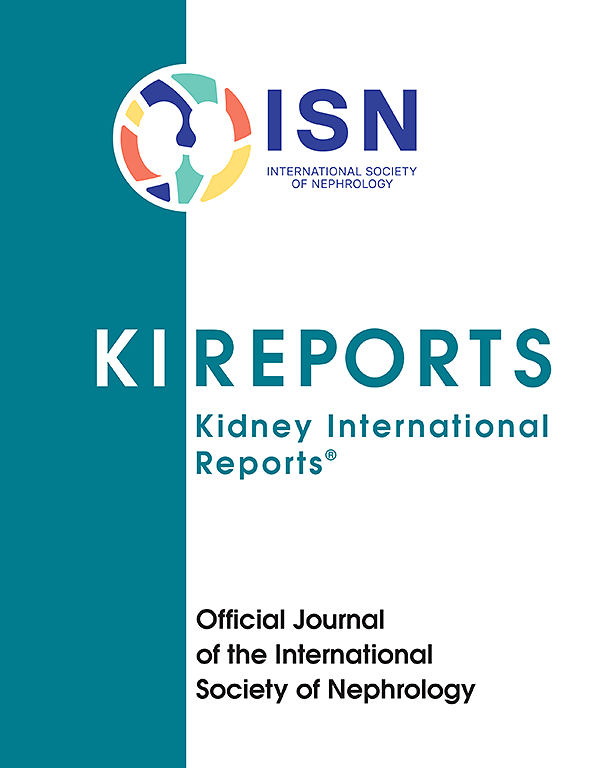A Pan-Inhibitor of Phosphate Transporters AP306 in Hemodialysis Patients
IF 5.7
2区 医学
Q1 UROLOGY & NEPHROLOGY
引用次数: 0
Abstract
Introduction
Hyperphosphatemia in patients undergoing dialysis is not well-controlled. AP306 is a pan-inhibitor of phosphate transporters, designed to block the active uptake of phosphate through the gastrointestinal tract.
Methods
In this phase 2 randomized, active-controlled, open-label study, hemodialysis patients with serum phosphate between 5.5 and 9.0 mg/dl were randomized to receive either AP306 or sevelamer carbonate for 12 weeks. The primary outcome was the change in serum phosphate levels from baseline until the therapy ceased. AP306 was initiated at 75 mg and adjusted stepwise to 125 mg and 150 mg orally thrice daily every 4 weeks, to maintain serum phosphate between 3.5 and 5.5 mg/dl. Sevelamer levels were adjusted using the same criteria and frequency.
Results
A total of 27 patients were randomized to receive AP306 and 28 to receive sevelamer. At the end-of-treatment, both AP306 and sevelamer resulted in a significant decrease from baseline in serum phosphate by 2.51 mg/dl (95% confidence interval [CI]:−3.07 to −1.92; P < 0.001) and 1.08 mg/dl (95% CI: −1.58 to −0.59), respectively. The proportions of patients achieving the recommended range as per the Kidney Disease: Improving Global Outcomes guidelines (2.5–4.5 mg/dl) were about 20% higher in AP306 than in sevelamer, starting from treatment week 5. The most reported adverse events (AEs) associated with AP306 were gastrointestinal disorders (51.9%), most of which were mild to moderate diarrhea (44.4%).
Conclusion
AP306 monotherapy significantly reduced serum phosphate levels and substantially improved the serum phosphate control rate in hemodialysis patients with hyperphosphatemia. AP306 was safe and well-tolerated.

血液透析患者磷酸转运蛋白AP306泛抑制剂
透析患者的高磷血症控制不好。AP306是一种磷酸盐转运蛋白泛抑制剂,旨在阻断磷酸盐通过胃肠道的主动摄取。方法:在这项2期随机、主动对照、开放标签的研究中,血清磷酸盐在5.5 - 9.0 mg/dl之间的血液透析患者随机接受AP306或碳酸西维拉默治疗12周。主要结局是血清磷酸盐水平从基线到治疗停止的变化。AP306起始剂量为75 mg,逐步调整至125 mg和150 mg,每日口服3次,每4周一次,以维持血清磷酸盐在3.5至5.5 mg/dl之间。使用相同的标准和频率调整Sevelamer水平。结果27例患者随机接受AP306治疗,28例患者随机接受sevelamer治疗。在治疗结束时,AP306和sevelamer均导致血清磷酸盐较基线显著下降2.51 mg/dl(95%可信区间[CI]: - 3.07至- 1.92;P & lt;0.001)和1.08 mg/dl (95% CI: - 1.58至- 0.59)。从治疗第5周开始,根据肾脏疾病:改善全球结局指南(2.5-4.5 mg/dl), AP306组达到推荐范围的患者比例比sevelamer组高约20%。报告的与AP306相关的不良事件(ae)最多的是胃肠道疾病(51.9%),其中大多数是轻至中度腹泻(44.4%)。结论ap306单药治疗可显著降低血透合并高磷血症患者血清磷酸盐水平,显著提高血清磷酸盐控制率。AP306是安全且耐受性良好的。
本文章由计算机程序翻译,如有差异,请以英文原文为准。
求助全文
约1分钟内获得全文
求助全文
来源期刊

Kidney International Reports
Medicine-Nephrology
CiteScore
7.70
自引率
3.30%
发文量
1578
审稿时长
8 weeks
期刊介绍:
Kidney International Reports, an official journal of the International Society of Nephrology, is a peer-reviewed, open access journal devoted to the publication of leading research and developments related to kidney disease. With the primary aim of contributing to improved care of patients with kidney disease, the journal will publish original clinical and select translational articles and educational content related to the pathogenesis, evaluation and management of acute and chronic kidney disease, end stage renal disease (including transplantation), acid-base, fluid and electrolyte disturbances and hypertension. Of particular interest are submissions related to clinical trials, epidemiology, systematic reviews (including meta-analyses) and outcomes research. The journal will also provide a platform for wider dissemination of national and regional guidelines as well as consensus meeting reports.
 求助内容:
求助内容: 应助结果提醒方式:
应助结果提醒方式:


